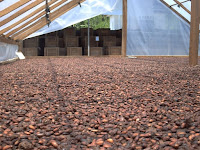All the
different usage of cocoa :
The husks of
cocoa pods and the pulp, or sweatings, surrounding the beans and the cocoa bean
shells can be used. Some examples of these uses are:
Animal feed from cocoa husk - As pelletised dry 100%
cocoa pod husk, it can be used as an animal feed. The animal feed is produced
by first slicing the fresh cocoa husks into small flakes and then partially
drying the flakes, followed by mincing and pelleting and drying of the pellets.
Production of soft drinks and alcohol - In the
preparation of soft drinks, fresh cocoa pulp juice (sweatings) is collected,
sterilised and bottled. For the production of alcoholic drinks, such as brandy,
the fresh juice is boiled, cooled and fermented with yeast. After 4 days of
fermentation the alcohol is distilled.

Potash from cocoa pod husk - Cocoa pod husk ash is used
mainly for soft soap manufacture. It may also be used as fertiliser for cocoa,
vegetables, and food crops. To prepare the ash, fresh husks are spread out in
the open to dry for one to two weeks. The dried husks are then incinerated in
an ashing kiln.
Jam and marmalade - Pectin for jam and marmalade is
extracted from the sweatings by precipitation with alcohol, followed by
distillation and recycling of the alcohol in further extractions.
Mulch - Cocoa bean shells can be used an organic mulch
and soil conditioner for the garden.
Once the beans have been fermented and dried, they can be
processed to produce a variety of products. These products include:
Cocoa butter - Cocoa butter is used in the manufacture of
chocolate. It is also widely used in cosmetic products such as moisturising creams
and soaps.
 |
| Cocoa Butter |
Cocoa powder - Cocoa powder can be used as an ingredient in almost any foodstuff. For example, it is used in chocolate flavoured drinks, chocolate flavoured desserts such as ice cream and mousse, chocolate spreads and sauces, and cakes and biscuits.
Cocoa liquor - Cocoa liquor is used, with other ingredients, to produce chocolate. Chocolate is used as a product on its own or combined with other ingredients to form confectionery products.

 Keep following this blog for more details on special packages!
Keep following this blog for more details on special packages!

















